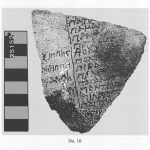| Artefact ID | 1234 |
| TM ID | TM 175275 |
| Findspot (DEChriM ID) | 48 (Madīnat Hābū) | Class | Textual |
| Material | Ceramic |
| Writing medium | Ostracon |
| Text content | Subliterary |
| Language | Greek |
| Description | P.Bagnall 10: School text Clay ostracon containing a Greek list of words. Since the ostracon is broken on the top and on both sides, it is impossible to determine whether the exercise was extensive or included only some sets of letters (here words starting with ξ on col. 1 and π on col. 2). The two existing columns are defined by a long vertical line. Some of the words suggesting a Christian milieu, acc. to ed.pr., are: Paganos (Christian term to designate polytheists); Pontius Pilatos; Patrobas (name of a Christian in Rome to whom St. Paul sent greetings in the Epistle to the Romans 16.14); Pathoures (Egyptian toponym that occurs several times in the Septuaginta, e.g. Jeremiah 51.5.14 and in some Christian writers such as Athanasius). This ostracon provides a good example of how Christians adapted traditional school exercises by changing the content. See also P.Worp 53. |
| Selection criteria | Christian terms/formulas/concepts, Biblical quote or paraphrase |
| Date from | 300 |
| Date to | 399 |
| Dating criteria | Palaeographically dated to 4th c. in ed. pr.: the hand is compared with that of P.Bour. 1 [now redated to 5/6th c.] and the Chester Beatty papyrus published by W. Clarysse and A. Wouters (TM 64288 / LDAB 5508, dated end 3rd/early 4th c.) and showing more uniformity because of the smoother writing material. |
| Absolute/relative date | Relative date |
| Archaeological context | Part of a group of nearly 300 ostraka, mostly Coptic, which were purchased in Cairo by the Copticist Carl Schmidt on behalf of the Kelsey Museum in 1936-1937, the majority of which are of Theban provenance. |
| Accession number | Ann Arbor, Michigan University, Kelsey Museum inv. 25152. |


 Json data
Json data




